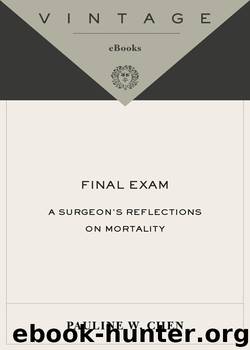Final Exam by Pauline W. Chen

Author:Pauline W. Chen [Chen, Pauline W.]
Language: eng
Format: epub
Tags: General, Health & Fitness
ISBN: 0307263533
Publisher: Vintage
Published: 2007-01-09T00:00:00+00:00
Hanging in Room 15 among the other paintings and sculptures that make up the Victorian Spectacle collection of London’s Tate Britain museum is a painting so well etched in my memory that I no longer remember the first time I saw it. The painting depicts daybreak in a small country cottage. A corner lamp highlights two figures: a young patient on the verge of recovery, with pink rising in her cheeks, and a serious physician whose intense paternal gaze seems to hold the answers to his patient’s mortal struggle.
The Doctor, first exhibited in 189184, was the work of Luke Fildes, a Victorian painter well known for his powerful images of social injustice and poverty. Fildes drew from his own memories in painting The Doctor; his eldest son had died on Christmas morning 1877. Despite his son’s death, the artist remained grateful to the physician, Dr. Gustavus Murray, and The Doctor not only paid homage to Dr. Murray but was also an attempt “to put on record85 the status of the doctor in our own time.”
That status had changed dramatically. Fildes and his contemporaries had been witness86 to a succession of medical discoveries that resulted in enormous changes in the public’s general welfare. Physicians and surgeons standardized their training and methods, abandoned antiquated notions like bloodletting and intestinal purgatives, and incorporated anesthesia and sterile techniques into their practices. The body was no longer a mysterious repository of disease but a rational, potentially reparable biological machine.
And doctors were the human purveyors of the revolution. Their ability to treat diseases empowered physicians, and that empowerment soon translated into an urge to treat not selectively but almost indiscriminately. The implicit meaning of the converse—doing nothing at all—came to represent a willful refusal of power and strength over disease.
That we can fend off disease and death through our actions is an intoxicating notion. I should know; it fueled many of my sleepless nights through training. There is no mistaking the heady exhilaration you feel when you walk into the cool and ordered operating room, pull out all the technical gadgetry and wizardry of the moment, and within a few hours solve the essential problem. Surgery is a specialty defined by action. As a student of mine once said, “Surgeons do something about a problem, not just sit around and think about it.”
But surgeons are not alone in this doer’s paradise. While surgery, particularly liver transplantation, represents an extreme, even physicians in specialties with little or no “invasive” procedures feel compelled to do. A patient visits with a problem, and the appointment is incomplete without a prescription for medications or tests or some tangible diagnosis.
Even medicine’s essential framework for approaching clinical problems—the treatment algorithm—presumes physician action. Frequently diagrammed in textbooks and medical journals, these algorithms outline step-by-step therapeutic plans for different diseases. For every point along the algorithm there are several possible outcomes that in turn may have several of their own possible therapeutic options. On no branch of the decision tree, however, is there a box reserved for Do nothing or Hold tight or Sit on your hands.
Download
This site does not store any files on its server. We only index and link to content provided by other sites. Please contact the content providers to delete copyright contents if any and email us, we'll remove relevant links or contents immediately.
| Anesthesiology | Colon & Rectal |
| General Surgery | Laparoscopic & Robotic |
| Neurosurgery | Ophthalmology |
| Oral & Maxillofacial | Orthopedics |
| Otolaryngology | Plastic |
| Thoracic & Vascular | Transplants |
| Trauma |
When Breath Becomes Air by Paul Kalanithi(7304)
Why We Sleep: Unlocking the Power of Sleep and Dreams by Matthew Walker(5691)
Paper Towns by Green John(4203)
The Immortal Life of Henrietta Lacks by Rebecca Skloot(3851)
The Sports Rules Book by Human Kinetics(3623)
Dynamic Alignment Through Imagery by Eric Franklin(3518)
ACSM's Complete Guide to Fitness & Health by ACSM(3488)
Kaplan MCAT Organic Chemistry Review: Created for MCAT 2015 (Kaplan Test Prep) by Kaplan(3446)
Introduction to Kinesiology by Shirl J. Hoffman(3324)
Livewired by David Eagleman(3166)
The River of Consciousness by Oliver Sacks(3015)
The Death of the Heart by Elizabeth Bowen(2931)
Alchemy and Alchemists by C. J. S. Thompson(2930)
Descartes' Error by Antonio Damasio(2765)
Bad Pharma by Ben Goldacre(2752)
The Gene: An Intimate History by Siddhartha Mukherjee(2518)
Kaplan MCAT Behavioral Sciences Review: Created for MCAT 2015 (Kaplan Test Prep) by Kaplan(2506)
The Fate of Rome: Climate, Disease, and the End of an Empire (The Princeton History of the Ancient World) by Kyle Harper(2459)
The Emperor of All Maladies: A Biography of Cancer by Siddhartha Mukherjee(2453)
